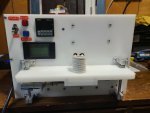I've never made any claims on annealing other than the seating force or neck tension becomes more consistent. I am not positive my AMP Mark 2 anneals the shoulder hard enough for any gains and no means or the will to test it.
But I have to say you do go against the grain. If your shoulder bumps are more accurate, and the seating feels more consistent, and now you can trim each firing making necks the same length also, and you are not seeing any gains in the numbers categories or results downrange, something is wrong. To me, it would seem impossible when you make things more consistent that there are no perceived benefits.
They were already fairly consistent to begin with, but certainly understand the concept you're
I've never made any claims on annealing other than the seating force or neck tension becomes more consistent. I am not positive my AMP Mark 2 anneals the shoulder hard enough for any gains and no means or the will to test it.
But I have to say you do go against the grain. If your shoulder bumps are more accurate, and the seating feels more consistent, and now you can trim each firing making necks the same length also, and you are not seeing any gains in the numbers categories or results downrange, something is wrong. To me, it would seem impossible when you make things more consistent that there are no perceived benefits.
Just to be clear, I wasn't referencing you. There were a few posts in here inferring their annealing had a direct correlation to their low ES/SD.
As far as seeing results on target, I just haven't so far; not sure what to tell you. I suspect it's because my shoulder bump was fairly consistent before (less so, but still consistent), I'm loading bullets that are relatively insensitive to seating depth (within a given depth window of course) , and the load wasn't all impacted by minor differences in neck tension.
Believe me, I'd love nothing more than to come into this thread and talk about how much better everything works now that I'm using an AMP...I still anneal everything I fire because I do believe it helps with consistency on the bench (and have a feeling of 'what if I didn't?'). I don't think it's a $1,400 paper weight, but in my experience so far, it hasn't yielded higher scores or X-counts.
Are you seeing demonstrably higher scores after annealing?


